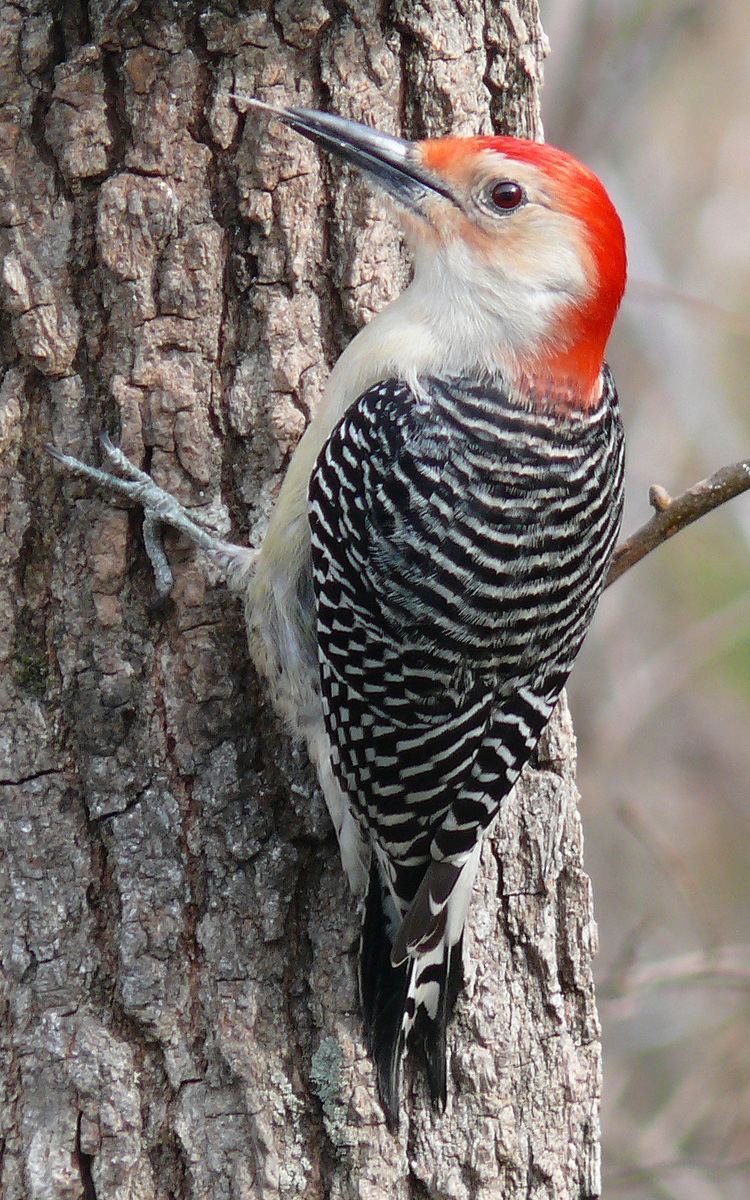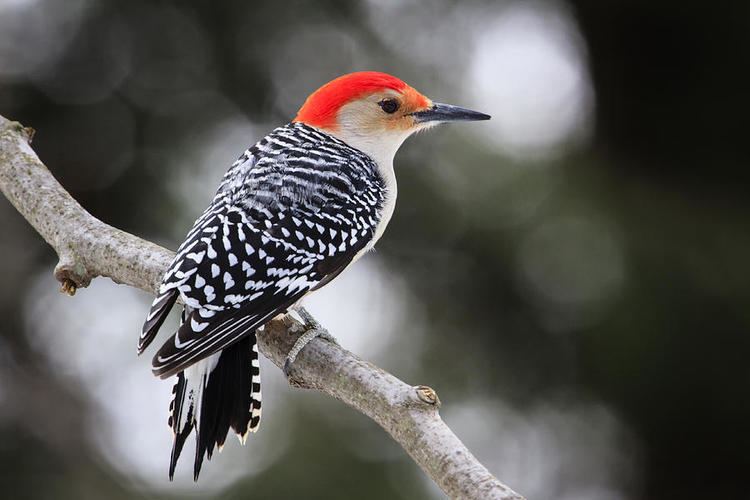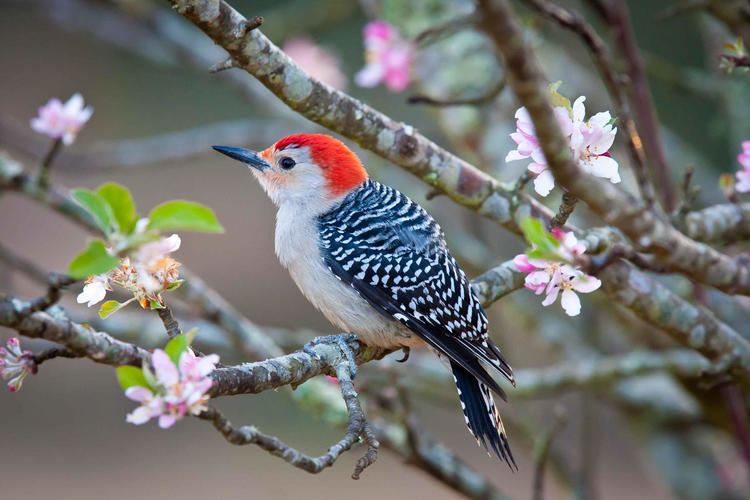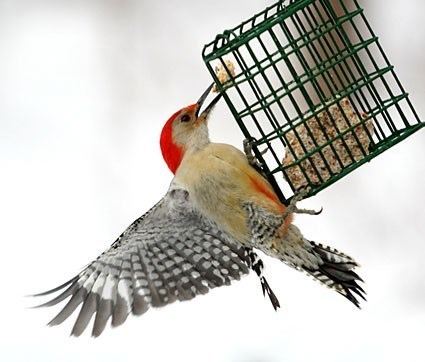Subclass Neornithes Superorder Neoaves Rank Species | Phylum Chordata Infraclass Neognathae | |
 | ||
Similar Woodpecker, Bird, Red‑headed woodpecker, Downy woodpecker, Pileated woodpecker | ||
Red bellied woodpecker vs starlings nest battle
The red-bellied woodpecker (Melanerpes carolinus) is a medium-sized woodpecker of the family Picidae. It breeds mainly in the eastern United States, ranging as far south as Florida and as far north as Canada. Its common name is somewhat misleading, as the most prominent red part of its plumage is on the head; the red-headed woodpecker, however, is another species that is a rather close relative but looks quite different.
Contents
- Red bellied woodpecker vs starlings nest battle
- Red bellied woodpecker with sound
- Description
- Vocalizations
- Foraging
- Predation
- Breeding
- Courtship
- References

It was first described in Linnaeus' Systema Naturae, as Picus carolinus. The type locality is given simply as "America septentrionalis" (North America).

Red bellied woodpecker with sound
Description

Adults are mainly light gray on the face and underparts; they have black and white barred patterns on their back, wings and tail. Adult males have a red cap going from the bill to the nape; females have a red patch on the nape and another above the bill. The reddish tinge on the belly that gives the bird its name is difficult to see in field identification. They are 22.85 to 26.7 cm (9.00 to 10.51 in) long, and have a wingspan of 38 to 46 cm (15 to 18 in).
Vocalizations

Red-bellied woodpeckers are noisy birds, and have many varied calls. Calls have been described as sounding like churr-churr-churr or thrraa-thrraa-thrraa with an alternating br-r-r-r-t sound. Males tend to call and drum more frequently than females, but both sexes call. The drum sounds like 6 taps.Often, these woodpeckers "drum" to attract mates. They tap on aluminum roofs, metal guttering, hollow trees and even transformer boxes, in urban environments, to communicate with potential partners. Babies have a high-pitched begging call of pree-pree-pree. They will continue to give a begging call whenever they see their parents for a while after fledging.

These birds mainly search out arthropods on tree trunks. They may also catch insects in flight. They are omnivores, eating insects, fruits, nuts and seeds. Their breeding habitat is usually deciduous forests. They nest in the decayed cavities of dead trees, old stumps, or in live trees that have softer wood such as elms, maples, or willows; both sexes assist in digging nesting cavities. Areas around nest sites are marked with drilling holes to warn others away.

Though the species is not globally threatened, it depends on large trees for nesting. In areas that are extensively deforested, the birds will sometimes utilize gardens, but for the most part simply will not be present in any numbers.
Foraging
As with all animals, foraging becomes an important role in an animal’s ability to survive and reproduce. The red-bellied woodpecker expresses foraging behavior by catching or storing food. The woodpecker uses its bill for foraging as a chisel drilling into bark or probing cracks on trunk of trees. In this manner, the red-bellied woodpecker is able to pull out beetles and other insects from the tree with the help of its long tongue. This behavior is also seen for storing food from other animals by hiding food behind bark or deep in cracks of a tree. According to studies from Williams 1975, Breitwisch 1977, and Batzil 1979, the red-bellied woodpecker spent 20% to 69% foraging on dead or decaying trees. In addition, Williams 1975, Breitwisch 1977, and Batzil 1979 observed red-bellied woodpecker 80% gleaning and probing and 10% excavating on trees in South Florida pine habitat. The red-bellied woodpecker relies on snags or dying trees for foraging and nesting. The red-bellied woodpecker is a major predator of the invasive emerald ash borer in the U.S. Midwest, removing up to 85 percent of borer larvae in single infested ash tree.
Predation
Predators of adult red-bellied woodpeckers include birds of prey such as sharp-shinned hawks and Cooper's hawks, black rat snakes and house cats. Known predators of nestlings and eggs include red-headed woodpeckers, owls, pileated woodpeckers, gray rat snakes and black rat snakes. When approached by a predator, red-bellied woodpeckers either hide from the predator, or harass it with alarm calls. They defend their nests and young aggressively, and may directly attack predators that come near the nest.
Breeding
In early May, the red-bellied woodpeckers begin breeding activities by drumming patterns; such as, slow taps followed by short rapid drumming. Woodpeckers depend on dead and drying wood for nesting purposes. The male red-bellied woodpecker takes the initiative in locating a nest hole. He will then seek approval from his female mate by mutual tapping. The red-bellied woodpecker excavates holes in trees for nesting and roosting. By excavating cavities, they play an important role in the forest communities for other species as well. For example, species such as squirrels and bats use these cavities as shelter. The female red-bellied woodpecker accepts the nesting hole by completing the excavation and entering the nest hole.
Researchers have documented that red-bellied woodpeckers have the tendency to nest in clear areas with only few trees. Studies have indicated that close canopy areas does not impact the bird's nesting behavior; however, further studies are needed and are in progress. Red-bellied woodpeckers are territorial during the nesting season and they breed once per year. A pair-breeding woodpecker begins nesting in April or May holding a year-round territories and showing high site fidelity.
Red-bellied woodpeckers depend on dead trees for nesting. Recent studies have shown that these woodpeckers experienced low breeding due to cutting sites of dead trees; however, predators are still of main concern. The juvenile red-bellied woodpecker are ready to fledge its nest at 24 to 26 days of age. Natal dispersal has been observed on juvenile red-bellied woodpeckers. The juvenile red-bellied woodpecker remains approximately 27 weeks in its natal area after fledging. In some cases, the woodpecker may return to its natal area for breeding depending on predation levels and food resources.
Courtship
It has been noted that vocal signals in red-bellied woodpeckers is used to attract and communicate with potential mates. A low "grr, grr" sound is observed in a pair of woodpeckers from the start of courtship until the end of the breeding season. In an intraspecific conflict, the red-bellied woodpeckers usually make a loud "chee-wuck, chee-wuck, chee-wuck" sound. As indicated by Kilham 1983, the red-bellied woodpecker drums with its bill during conflict situation and taps to maintain pair bonding. An example of a conflict event between red-bellied woodpeckers would be competing for the same mate. Nevertheless, the red-bellied woodpeckers are known to be in monogamous relationships.
